5 Ways Women Defied the British Raj and Helped Secure India’s Independence
Guest post from Chloë Gardner.
In British colonial India, the battlefield was not just for men. For every male rebel against the British Raj, there was a woman helping from behind, or going further than he was prepared to go. Their names deserve to be etched alongside Mahatma Gandhi’s, for their courage and sacrifice are equally profound. From protests to boycotts, from hunger strikes to acts of defiance, women of every caste, religion, and ethnicity stood as equals alongside their male counterparts, determined to free their land and empower all women. Below you can learn more about some of the ways that women stood against the biggest empire the world had ever known and won.
- With the sword

From queens such as Rani of Jhansi or Ahilya Bai Holkar who led armies of loyal soldiers to drive the British from their lands, to housewives who had little but pots and pans with which to drive the British from their villages, many women took up arms against the invaders and proved just as formidable a foe as any man. Neither age nor caste precluded these women from their violent retribution: Aanti Ghose and Suniti Choudhury were two sixteen-year-old girls who assassinated a British magistrate, while the body of a young soldier shot by British fire was discovered to be a young girl from the lowest caste who had disguised herself as a man to join the fight. Women, especially Asian women, are often depicted as meek and weak, passive victims of male and/or colonial violence with little say in their fate. That could not be further from the truth, as is evidenced by the many women who took up the sword against their oppressors and drove them out using military might or other direct means.
- With the pen

While many women favoured M.K. Gandhi’s non-violent approach to rebellion, this did not make them any less aggressive in their fight against the British. Those who were educated and fluent in English frequently chose the pen as their weapon of choice, writing poems, songs, and eviscerating essays on the horrors of colonial rule. Sarojini Naidu, dubbed The Nightingale of India, used her way with words to encourage Indians, especially women, of all backgrounds to put their religious, caste, and class differences aside and unite against their common enemy. Renuka Ray wrote prolifically – most famously in her autobiography. She documented the evils that the British had committed in her lands, highlighted the hypocrisy of the British government (especially during the first and second world wars), and explained the motivations of freedom fighters like herself. Despite British attempts at censorship, such “seditious” writings spread beyond the women’s own communities and brought world-wide attention to their cause. Today, these writings are a lasting testament to the arguments that independence fighters used in their quest for freedom, and to the indomitable fire of the women who helped them achieve it.
- With their voices
Even those women who could not write made sure their voices were heard. Thousands took to the streets to peacefully protest against British rule and publicly campaigned for the Home Rule and Quit India movements. Some managed to break through the barriers of race and religion to win themselves seats on advisory committees and make real change with their decrees and votes. Even where they were excluded from formal discussions, women proved invaluable advisors to their husbands, sons, brothers, and colleagues (who then went on to take all the credit). Other women such as Ruttie Jinnah used more subtle forms of resistance, by publicly chastising British soldiers for their treatment of women, refusing to answer their questions at road check points, and even naming their dogs after British officials as an ultimate sign of disgust. Whenever the British tried to silence one voice through violence or censorship, a thousand more joined her call and amplified the message even more. Without these collective calls for freedom, more united than the men by their shared sisterhood, the British would never have listened.

- With their bodies
Aside from their voices, women used their bodies in other ways to express their resistance. One of the most common was by hunger strike. While Mahatma Gandhi is well-known for his excessive hunger strikes, it is completely forgotten that his wife, teenage nieces, and female followers also refused food in protest at their treatment (and the treatment of all Indians). As well as hunger strikes, many women’s final act of defiance was to sacrifice their body for the cause by becoming martyrs. One 73-year-old woman Matangini Hazra put herself in the line of fire to protect other protestors, while some like Pritilata Waddedar ended her own life rather than surrender to the British after committing an attack on a British social club. Such deaths proved a rallying cry for other rebels and revolutionaries and had a lasting impact on the movement long after the women themselves had passed on.
- With their money (or withholding of it)
One of the most powerful ways to destroy a global superpower is through its coffers, a fact that the women of India knew all too well. Many donated money and where no cash was available to them, their jewellery (often a woman’s only personal financial asset) to the independence movement. However, even more powerful than funding their purses was robbing the British of theirs. Women played an active role in the boycott of British goods, in protest at the British robbing Indian resources and then selling them back to the people at an inflated rate. Women picketed stores selling British goods, made and encouraged others to make their own textiles rather than buying or selling them to the British, and participated in (and took leadership of) the famous 24-day Salt March led by M.K. Gandhi to protest the British salt monopoly and show the people that Indians were capable of making their own salt. Women were frequently arrested and punished for participation in these acts of civil disobedience, but this only drew further attention to their cause and bolstered calls for Indians to refuse their taxes and become self-sufficient as far as possible. This movement, along with the crippling expensive of the World Wars, ensured that domination of the “jewel in the crown” was no longer viable, which, combined with increasing awareness that Indians would no longer tolerate their oppression, convinced the British to relinquish control and hand the power back to the Indian (and newly created Pakistani) people.


Women Against the Raj is available to order here.

